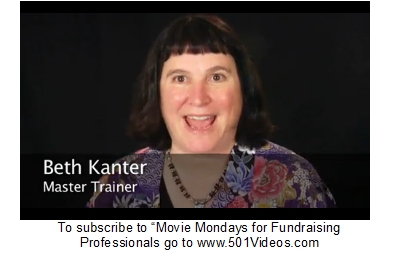 Welcome to O.D. Fridays at DonorDreams blog. Every Friday for the foreseeable future we will be looking at posts from John Greco’s blog called “johnponders ~ about life at work, mostly” and applying his organizational development messages to the non-profit community.
Welcome to O.D. Fridays at DonorDreams blog. Every Friday for the foreseeable future we will be looking at posts from John Greco’s blog called “johnponders ~ about life at work, mostly” and applying his organizational development messages to the non-profit community.
In a post titled “People-Service-Profit,” John talks about the impact that Federal Express’ corporate philosophy of People-Service-Profit has on it employees . . . which in turn has an effect on customer service and loyalty . . . which ultimately is reflected on the bottom line in profit
When reading John’s blog post this week, I immediately had two thoughts, which I will address below in two different sections.
Non-profit culture
People who work for non-profit organizations are different. In my experience, they aren’t motivated by the same things as their for-profit counterparts. Here are just a few examples of what I’ve seen people on the frontline of the non-profit sector do:
- They often agree to work for less money than they otherwise might earn working in the for-profit sector.
- I’ve seen non-profit employees work longer hours than they’re asked (or authorized to do). I’ve even seen hourly employees fudge their timesheet in order to avoid overtime (e.g. they get in trouble for working unauthorized time . . . overtime isn’t part of most agency’s budgets).
- I’ve seen program assistants purchasing supplies for their programs using their personal money because there isn’t enough agency funding to do so.
 The point I’m trying to make is that most non-profit organizations have built a culture that revolves around THE CLIENT. This focal point is so intense that ideas threatening to shift that focus are often seen as heresy.
The point I’m trying to make is that most non-profit organizations have built a culture that revolves around THE CLIENT. This focal point is so intense that ideas threatening to shift that focus are often seen as heresy.
While many people see a client-focused philosophy as altruistic, there can be a cost to this kind of corporate philosophy.
- Low employee morale
- Burnout
- Cynicism
- Poor staff cohesion
Another significant negative effect of this philosophy is “The Nonprofit Starvation Cycle”. I talked about this phenomenon in a previous “DonorDreams: O.D. Fridays” post on July 26, 2013 titled “Is your non-profit only living for today? Then you need Picasso!”
In the Picasso post, I describe how senior leadership and board volunteers are blinded by the agency philosophy of CLIENT FIRST, which results in zero funding important organizational capacity building expenditures. The end result is a non-profit that has no capacity and starves itself out of business.
Heck, in yesterday’s post about budgeting, I confessed that when I was an executive director, my finance committee once convinced me to eliminate donor newsletters from the budget in order to balance it. Ugh . . . while this was done in the name of putting the CLIENT FIRST, the result was putting the donor second (which is the person who needs to see ROI on their investment if they are going to renew their support). How did THAT make any sense?
So, let’s jump back to John’s post about company philosophy and FedEx.
If you are an executive director or someone who supervises staff, you should click-through and read the 10 bullet points located in the middle of John’s post. After reading those FedEx examples of how managers should treat their employees, I encourage you to complete the exercise described in the paragraph after the list.
It likely will be an eye-opening experience for you.
The Loyalty Effect
 I suspect many non-profit people who are reading today’s post are probably still not convinced that a CLIENT FIRST philosophy can be damaging.
I suspect many non-profit people who are reading today’s post are probably still not convinced that a CLIENT FIRST philosophy can be damaging.
More than a year ago, I wrote a week long blog series focused on “The Loyalty Effect: The Hidden Force Behind Growth, Profits, and Lasting Value,“ which is a book written by Frederich Reichheld. I mostly focused on translating some of his business themes into resource development messages.
However, one of Reichheld’s bigger points is how employee loyalty drives customer loyalty, which turns into profit on the bottom line.
If you are still one of those skeptics when it comes to this post, look at it from this perspective . . .
Many of your clients have “special relationships” with your staff. In fact, if you surveyed your clients, I suspect they would say they come to your agency primarily because of that relationship and secondarily because of your services. I know for a fact this was true for the kids using the programs at my former agency.
So, investing in your employees results in their retention and loyalty. This in turn keeps your customers coming back, which in turn drives impact and program results. When you communicate this impact (e.g. ROI) to donors, it improves your donor loyalty rates and you raise more money.
Please don’t misinterpret me here.
I am NOT suggesting you shouldn’t strive to make your clients happy and provide them with the best possible programming. However, I am saying the non-profit sector needs to take a page out of FedEx’s book and figure out how to invest in its people. It will make a huge difference in so many different ways!
Putting your employees first IS putting your customers first because your employees will put the customer first especially if your organizational values drive them to do so.
If you have some time this morning, I also encourage you to jump in the “way back machine” and check out that six part blog series about donor loyalty as it relates to some of Reichheld’s loyalty principles:
- A dog’s world: An introduction
- A dog’s world: Part 1 of 5
- A dog’s world: Part 2 of 5
- A dog’s world: Part 3 of 5
- A dog’s world: Part 4 of 5
- A dog’s world: Part 5 of 5
Want to change? Where to start?
If this post has you thinking about creating a different company culture, you may want to check out a post by Inc.com titled “How to Create a Company Philosophy“. It is definitely worth the click! 😉
Did you click-through and read John’s 10 bullet points? If so, how well did your agency do? What are you doing to invest in your employees? Is your organization avoiding the starvation cycle? If so, how are you making the case for investments in capacity building? Have you ever correlated your employee turnover to client turnover to donor turnover? If so, what have you found? Please scroll down and share your thought and experiences in the comment box below.
Here’s to your health!
Erik Anderson
Founder & President, The Healthy Non-Profit LLC
www.thehealthynonprofit.com
erik@thehealthynonprofit.com
http://twitter.com/#!/eanderson847
http://www.facebook.com/eanderson847
http://www.linkedin.com/in/erikanderson847

 You know what Douglas Adams says (according to
You know what Douglas Adams says (according to  When I look at my email inbox, I do a lot of scanning. I first look at the names of people who sent me something. As I do this, I am deleting anything that vaguely looks like spam or advertising. I don’t even open it. After this first purge, I re-visit those who are left standing and start looking at subject lines. I’m essentially trying to prioritize what I should open first versus leave for later when I have more time. And when I say “leave for later,” it could be days or weeks later.
When I look at my email inbox, I do a lot of scanning. I first look at the names of people who sent me something. As I do this, I am deleting anything that vaguely looks like spam or advertising. I don’t even open it. After this first purge, I re-visit those who are left standing and start looking at subject lines. I’m essentially trying to prioritize what I should open first versus leave for later when I have more time. And when I say “leave for later,” it could be days or weeks later. As with most things in this world, there are different schools of thought on different things. While working with a client recently, I was reminded of the two camps that non-profit professionals tend to fall into when it comes to writing vision statements. So, I thought it would be fun this morning to explore both perspectives.
As with most things in this world, there are different schools of thought on different things. While working with a client recently, I was reminded of the two camps that non-profit professionals tend to fall into when it comes to writing vision statements. So, I thought it would be fun this morning to explore both perspectives. Welcome to O.D. Fridays at DonorDreams blog. Every Friday for the foreseeable future we will be looking at posts from John Greco’s blog called “
Welcome to O.D. Fridays at DonorDreams blog. Every Friday for the foreseeable future we will be looking at posts from John Greco’s blog called “ One of the pre-test questions that tends to trip people up is whether or not the board has a responsibility to “oversee the CEO“. Believe it or not, it isn’t uncommon for one-quarter to one-third of board volunteers to say “NO“.
One of the pre-test questions that tends to trip people up is whether or not the board has a responsibility to “oversee the CEO“. Believe it or not, it isn’t uncommon for one-quarter to one-third of board volunteers to say “NO“. So, maybe you don’t know where to start?
So, maybe you don’t know where to start? Welcome to O.D. Fridays at DonorDreams blog. Every Friday for the foreseeable future we will be looking at posts from John Greco’s blog called “
Welcome to O.D. Fridays at DonorDreams blog. Every Friday for the foreseeable future we will be looking at posts from John Greco’s blog called “ If I’ve seen it once, I’ve seen it hundreds of times. And I bet you have, too. I will omit the names to protect the innocent.
If I’ve seen it once, I’ve seen it hundreds of times. And I bet you have, too. I will omit the names to protect the innocent. We’ve also all seen this situation.
We’ve also all seen this situation. A non-profit organization that doesn’t invest time and resources into evaluation and critique is akin to an ostrich sticking its head in the sand.
A non-profit organization that doesn’t invest time and resources into evaluation and critique is akin to an ostrich sticking its head in the sand. Over the years, I’ve met non-profit board volunteers who didn’t see value or the need for staff. Likewise, I’ve met countless numbers of staff who complain about their board members. I’ve also met executive directors who deliberately do things to disengage their board volunteers (e.g. taking on fundraising responsibilities, reducing the number of board meetings, etc).
Over the years, I’ve met non-profit board volunteers who didn’t see value or the need for staff. Likewise, I’ve met countless numbers of staff who complain about their board members. I’ve also met executive directors who deliberately do things to disengage their board volunteers (e.g. taking on fundraising responsibilities, reducing the number of board meetings, etc). Board member engagement is a common thread running through many of my blog posts. This isn’t because I’m a broken record. The fact of the matter is that so many of the things that plague non-profits are simply “symptoms” of a bigger problem. Yep, you guessed it . . . the root cause of many of our challenges in the can be traced back to our boards.
Board member engagement is a common thread running through many of my blog posts. This isn’t because I’m a broken record. The fact of the matter is that so many of the things that plague non-profits are simply “symptoms” of a bigger problem. Yep, you guessed it . . . the root cause of many of our challenges in the can be traced back to our boards. When I engage non-profit organizations in board development related issues, it can be like simultaneously operating in two parallel and polar opposite universes. One universe exists where everyone is talking about how things are “supposed to be” done. This is described in the agency’s written board development plan. In the other universe, there are board members and staff sitting around a table talking about “some guy” they know without any discussion about board composition gap assessment, prospect lists, prospect evaluation or anything that sounds like process.
When I engage non-profit organizations in board development related issues, it can be like simultaneously operating in two parallel and polar opposite universes. One universe exists where everyone is talking about how things are “supposed to be” done. This is described in the agency’s written board development plan. In the other universe, there are board members and staff sitting around a table talking about “some guy” they know without any discussion about board composition gap assessment, prospect lists, prospect evaluation or anything that sounds like process. With this in mind, I am reminded of an old “Mondays with Marissa” post from a year ago titled “
With this in mind, I am reminded of an old “Mondays with Marissa” post from a year ago titled “ Welcome to O.D. Fridays at DonorDreams blog. Every Friday for the foreseeable future we will be looking at posts from John Greco’s blog called “
Welcome to O.D. Fridays at DonorDreams blog. Every Friday for the foreseeable future we will be looking at posts from John Greco’s blog called “ Do you see it? Culture eats strategy!
Do you see it? Culture eats strategy! Hmmmm … looking back at that meeting, I think he was cooking up a hearty breakfast for me.
Hmmmm … looking back at that meeting, I think he was cooking up a hearty breakfast for me.